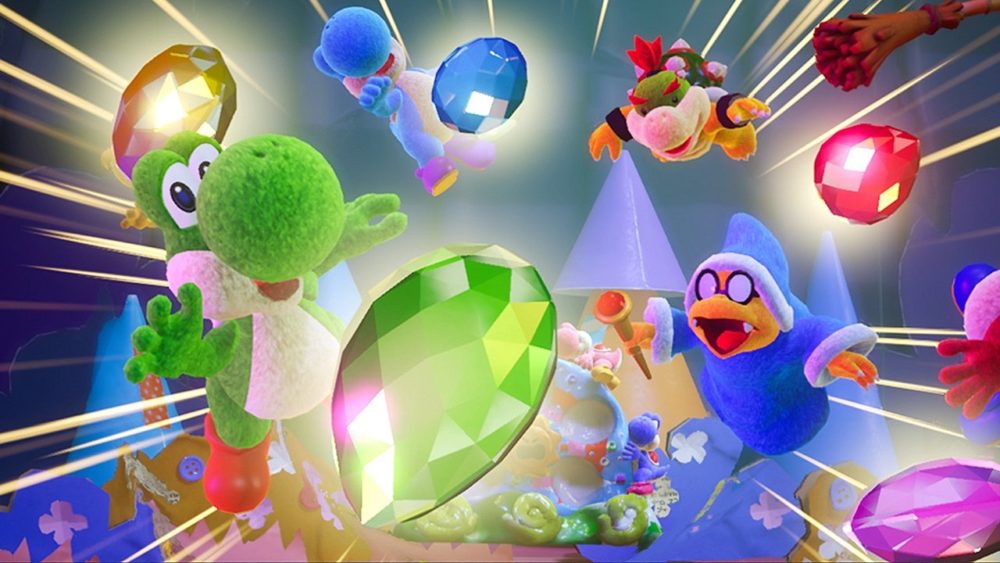
The subject of difficulty in gaming is something of a live grenade at the moment. With all of the hubbub surrounding the argument whether or not games should be more accessible, perhaps there’s an opportunity to take a look at the other side of this coin, and analyze a series that has been hamstrung somewhat by its insistence to cater to a younger audience.
So we’re swallowing that grenade, pooping it out as an egg and flinging it at our foes, as we take a look at the Yoshi franchise. Brrring-ha!
First off, a disclaimer: this isn’t trying to suggest that the newly released Yoshi’s Crafted World isn’t a fine game. It attained an admirable score of 4/5 here on Twinfinite, and presently teeters around the 80 mark on Metacritic.
Effectively, we got what we were expecting with the latest entry into the cuddly franchise: a light, fun adventure that can be enjoyed by players of all ages, packed to the gills with creative and magical touches, but ultimately a bit of sweet nothingness when it was all said and done.
Yoshi games have been this way for so long, it’s become par for the course. Keep in mind, however, that it didn’t exactly start this way.
The loveable dinosaur’s first starring role in a platformer was in Yoshi’s Island on the Super Nintendo back in 1995. Its art style was deliberately cartoony and playful to distance itself from the revolutionary pre-rendered aesthetic of Donkey Kong Country, a sentiment that has carried on to this day, but otherwise, it played quite differently to its successors.
The controls were much the same, of course. Tongue lashing, flutter jumping, ground pounding, gobbling and eggifying enemies to be used as ammunition — the standard Yoshi arsenal.
But the tone was different. It didn’t pander, and it didn’t hold your hand beyond the tutorial level.
Yoshi’s Island wasn’t infuriatingly hard by any means, but it was on par with other Nintendo platformers of its era. It oozed panache and it threw new curveballs at you here and there, whether it was the ability to transform into different vehicles, or inventive boss battles featuring enormous versions of the minions you had been battling in that particular fortress.
The inclusion of Baby Mario is divisive, but the panic of trying to rescue him when he’s been snatched from your safety is definitely a unique mechanic, adding an extra wrinkle to the gameplay.
Basically, Yoshi’s Island appeared to be reflective of what the character was in the Super Nintendo days; that indelible 90s cool. It was wild, bombastic at times, and overall rebellious. Remember the maligned gross-out commercial that aired in the US? Doesn’t exactly scream ‘kiddie game’, does it?
Maybe this was never the direction Nintendo wanted for the character, however. The equivalent Japanese commercial was much closer in style to what we would see today. It was cute, like Yoshi. The game itself may be deceptively tricky, but the character, it seems, was not meant to be, and this take was fully realized when the sequel arrived on the Nintendo 64.
Yoshi Story released to international audiences in 1998, and it was practically a 180 from what we had seen. Where we had once seen the menacing Naval Piranha or the disturbing Sluggy the Unshaven, we now had the roly-poly Don Bongo and Cloud N. Candy, a boss that is literally sweet enough to eat.
The character design changes weren’t the biggest shift, however. That honor belonged to the difficulty level, which had been basically swept out from under Yoshi’s feet. Eat 30 pieces of fruit, progress. At the end of six stages, you’ll duel with Baby Bowser in a simplistic battle, save the Super Happy Tree, and be rewarded with a charming ditty belted out by the childlike Yoshis.
In just one generation, Yoshi had been repurposed from dynamic egg-flinging wunderkind to squeaky-voiced, ultra-adorable kiddie mascot. Extreme Dinosaurs downgraded to Barney & Friends (don’t argue with my analogy, the Extreme Dinosaurs were radical, dude).
And that’s where we’ve sat ever since. Though Yoshi Story was the biggest culprit for excessive breeziness, it set a trend for what niche the character would fill: if you desired tight platforming and fast-twitch reflex moments, Donkey Kong was your guy. If you wanted colorful characters and an experience that young children would enjoy, you’d choose a Yoshi game.
He munched on baddies, floated majestically through the air, and has the occasional yarn aesthetic attached.
Sound familiar? It should, because it pretty much parallels another Nintendo character.
Kirby games have taken a similar path towards all-encompassing accessibility, in a manner most telling with last year’s Star Allies. In a sense, it feels like we’re doubling up on our resources here. Though the two characters have different playstyles and movesets, they’re catering to the same audience, and those more familiar with their earlier entries are left feeling underwhelmed.
Being the family-friendly brand is Nintendo’s MO, of course. This shouldn’t insinuate that Yoshi should be made edgier in some misconceived Shadow the Hedgehog manner, but rather, he ought to be elevated back to parity with his contemporaries.
Yoshi’s Crafted World does amp the difficulty from the pre-established standard, particularly in its post-game, but it’s still all fluff, if you’ll pardon the pun. Not even the direct Island sequels, Yoshi’s Island DS and Yoshi’s New Island on the 3DS, came close to the level of challenge offered by the original, carrying the mantle in name only.
This is what Yoshi has become, for better or worse. He’ll offer you all kinds of playful opportunities to be delighted, but if you want a little bit more, he just doesn’t have it in him nowadays.
ncG1vNJzZmisp567p7XNoqueZp6awXB%2Bj2pwaGhkZMawv8eiZKCZnZrAbrTAr5xmrJ9ir6Z5xJqqsmWnncZw